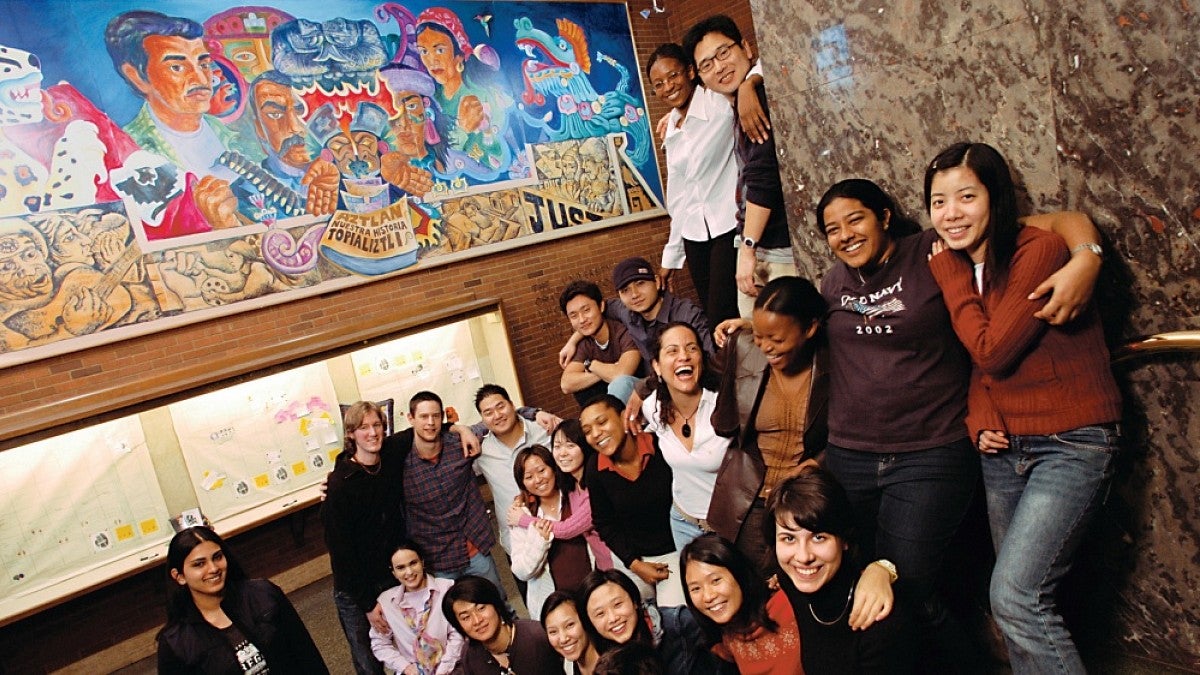When the UO offered to send its first group of international student ambassadors into local classrooms 35 years ago, Peter Briggs remembers getting a less-than-enthusiastic response.
“The first year a total of three teachers showed up,” said Briggs, then the assistant director of what was called the UO International Student Office. “I tried doing it again the second year and five teachers showed up.”
But by the third year, interest in the UO’s International Cultural Service Program had taken off. Ninety-five teachers came to the meeting to get in on the chance to have university students from around the globe speak to K-12 students about life in other countries.
The program never looked back, and this week a group of 40 alumni and friends will gather for one of the few reunions held in the program’s history. The aim is not just to remember the past and celebrate the program but to network and find ways to secure its future.
Representatives from each decade will attend, with alumni visiting from as far away as France, Germany and Hong Kong. The list of participants includes UO alumni who now work in technology, media, education, science and economics.
The program offers scholarships to international students with the ability to succeed in higher education who otherwise wouldn’t be able to afford to travel to the United States for an education. In return, the students spend a certain number of hours each week doing outreach in the community.
“The scholarship is for high-need, high-potential international students,” said Abe Schafermeyer, current director of the UO’s International Student and Scholar Services. “The awards have a range based on needs. We provide the least amount that can be given, so we can increase the footprint of the funds to as many as possible.”
In many ways, each student ambassador becomes a walking and speaking encyclopedia of cultural knowledge from his or her respective country. Over the years, the program has produced 584 cultural ambassadors from 118 countries worldwide.
One way to demonstrate the character and complexity of the students associated with the cultural service program is by looking at some of its recent graduates.
Among the 2017 graduates are award-winning architect Dristi Manandhar, who designed strong and economical shelters in her native Nepal after the 2015 earthquake. She earned a master’s degree in architecture and will join reconstruction efforts in Nepal.
Recent graduate Yi Na, a native of Tibet and a linguistics major, was raised in Siyuewu Village, a nomadic farming community of about 500 people. In the course of her studies, she developed a research project to create a writing system for her people, a group of less than 1,500 nomads who speak a language called Khroskyabs.
Biologist Shatgul Ablikim, a Uyghur speaker from China, served as one of the key faces of cultural diversity during the 2014 World Junior Championships. She was joined by student cultural ambassadors Awab Al-Rawe and Seela Sankei, who represented their respective countries — Iraq and Kenya — during the international procession of flags on Hayward Field.
One story that illustrates the program’s significance and influence comes from Kimeli Naiyomah. Naiyomah is from a Maasai village in western Kenya. Against significant odds, Naiyomah attended the UO, Stanford University and Duke University.
He was responsible for the 14 Cows for America, the sole official gift to the United States from the Republic of Kenya in memory of the attacks of Sept. 11, 2001. His story inspired a children's book and demonstrated to many around the world how a generous act, even from a small village, can be a symbol of hope and friendship.
At its peak in the late 1990s, the program had as many as 51 scholarship recipients. But funding issues have since led Schafermeyer to focus resources on a smaller body of students, and today the program has 33 scholarship recipients.
The 2017 reunion is not just a social gathering but an attempt by program alumni to leverage their networks and begin strategizing on how they might help the program survive as it heads toward its 50th anniversary.
Schafermeyer and alumni leaders have set a visionary goal of raising $1 million for new scholarships. In just a few short weeks, inspired alumni have raised more than $100,000.
Schafermeyer said he cannot imagine a better investment in UO scholarship programs.
“Because this program is one of the few options for an international student to get a full ride, it is a very competitive scholarship,” he said. “You get the best students from around the world that don’t have the financial resources to come to the UO.”
When the program reaches its goal, the funding will double the number of international students and expand the program to schools across the state.
Nelson Perez, a student ambassador and human physiology major from Chile, said he never would have made it to Eugene if not for the program. He thinks having student ambassadors helps people better understand many issues currently being debated in the U.S.
“After all, the United States is a huge country; it has people from all different backgrounds,” he said. “Sharing knowledge, sharing points of view is what’s building up this big, diverse community that Eugene is becoming. It feels good to be here.”
—By Chakris Kussalanant, University Communications


